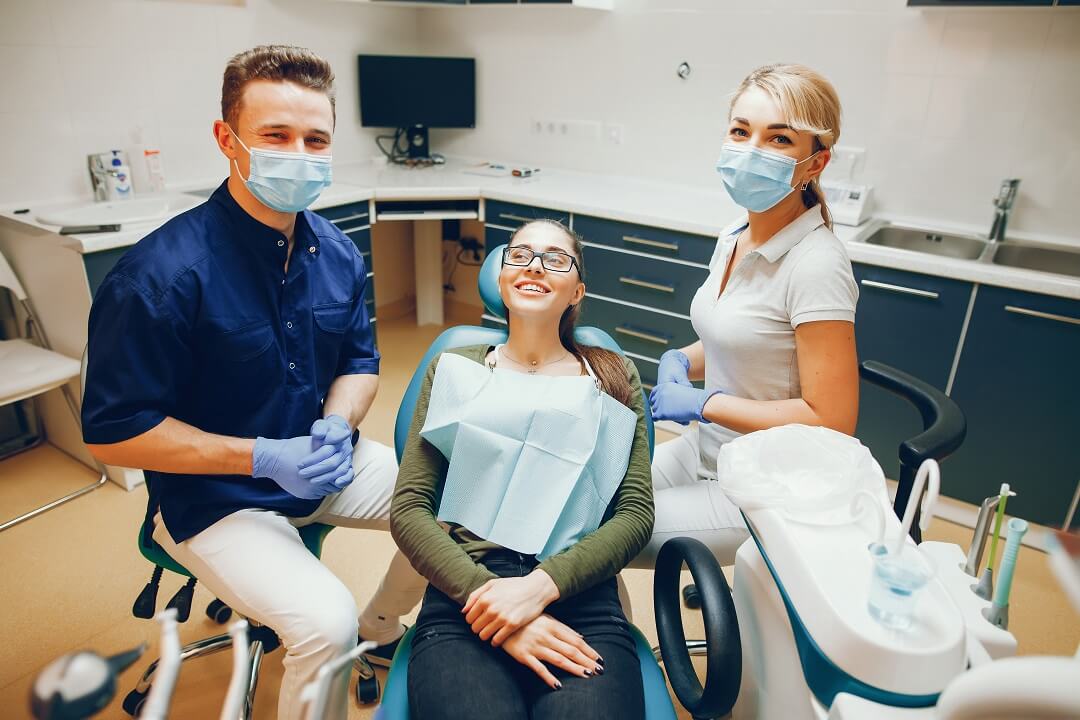Dental implants are a transformative solution for those missing one or more teeth. They provide cosmetic enhancement and functional stability for your oral health. However, like all medical procedures, the journey doesn’t end once the implant is placed; the recovery process is crucial.
This guide will give you a comprehensive understanding of the post-implant recovery timeline. This article ensures you’re well-prepared for what’s ahead, from immediate aftercare to the steps and precautions to take weeks after the procedure.
Let’s delve into the specifics of the dental implant procedure and its subsequent recovery, ensuring that every Edmonds resident has the knowledge to champion their healing process.
Key Takeaways
- Dental implants take time to heal, but the wait is worth the shiny smile you get!
- Recovery has different stages: from the first 48 hours, the first week, a few weeks in, and even past a month. Patience is key!
- Keeping your mouth clean and eating soft foods can help make a recovery smoother.
- It’s rare, but sometimes there are bumps in the road, like infections. Always talk with your dentist if something feels off.
Dental Implant Procedure: Brief Overview
For many residents of Edmonds, the thought of undergoing a dental procedure can be daunting, especially when they’re not entirely sure what it entails. Here’s a concise breakdown of the dental implant procedure to demystify the process and put your worries to rest.
1. Initial Consultation
Before anything else, you’ll have a consultation with your dentist. During this session, the dentist evaluates your oral health the condition of your jawbone, and discusses your medical history to ensure you’re a good candidate for the procedure.
2. Preparatory Work
Some patients might need preparatory procedures like tooth extraction or bone grafting. A bone graft is especially considered if the jawbone isn’t thick enough or is too soft to support an implant.
3. Implant Placement
This is the core part of the procedure. Under local anesthesia, a titanium post (the implant) is surgically placed into the jawbone. This post acts as an artificial root and will eventually hold the new tooth.
4. Healing and Osseointegration
Once the implant is placed, the healing process begins. A crucial phase called osseointegration occurs, where the jawbone fuses with the implant. This can take several weeks or even months, but it’s essential for providing a solid base for your new tooth.
5. Abutment Placement
After healing, an abutment, a small connector, is placed on top of the dental implant to hold the tooth. Depending on the method used, some patients might need to undergo a separate procedure for this, while for others, the abutment is placed with the implant.
6. Custom Tooth Creation and Placement
Finally, impressions of your mouth will be taken to create a custom tooth (or crown). Once ready, this crown is attached to the abutment, completing the dental implant procedure.
Although the dental implant procedure can seem intricate, it’s a tried-and-true process that has restored the smiles of countless Edmonds residents. With an understanding of the procedure itself, you’ll be better equipped to manage and anticipate the following post-procedure care, ensuring the longevity and success of your dental implant.

Implant Recovery Time
Getting a dental implant is just the start. What comes after, the healing time, is super important. Think of it like planting a tiny seed and caring for it so it grows strong. This healing time isn’t the same for everyone. Some might heal faster, while others take a bit longer. It can depend on your age, overall health, and how well you follow the dentist’s advice.
Immediate Post-Op (First 24-48 hours)
In the hours following the procedure, you’ll likely experience some pain or discomfort, which is normal. Additionally, some swelling and bleeding can be expected around the implant site. Don’t be overly concerned, as these are common reactions your body has to the procedure.
One of the best things you can do for yourself during this time is to rest. Your body heals most effectively at rest, so lie down with your head slightly elevated, even when sleeping. This position can help reduce swelling. If you notice swelling or feel pain, consider applying an ice pack to the side of your face where the procedure occurred. Aim for intervals: 15 minutes with the ice pack on, then a 15-minute break.
Your choice of food and drink is also essential during this phase. Opt for soft foods that don’t require much chewing—yogurt, pudding, and mashed potatoes are good choices. Drink lots of water to stay hydrated, but avoid using straws, as the sucking motion might disturb the implant site. Also, avoiding very hot drinks for a while is wise, as they could aggravate the swelling.
As for oral care, the first day after the procedure is a delicate time. When brushing your teeth, approach the area around the implant cautiously and gently. It’s also advised to avoid rinsing or spitting with too much force.
Lastly, it’s a good time to hold off on strenuous activities. Intense exercise or lifting heavy objects should be avoided. And if you’re a smoker, consider refraining from smoking during this time, as it can hinder the healing process.
Always remember: your body is equipped to heal, especially when given the right care. By following this advice, you’re paving the way for a smoother recovery. But never hesitate to contact your Edmonds dentist if something feels off or if you have any concerns. They’re always ready to assist and ensure your recovery is on track.
First Week After Procedure
The first week after getting a dental implant marks a significant transition in your recovery journey. While the immediate post-op phase focuses on acute care, this week is all about nurturing the healing process and preventing any complications.
As the week progresses, the initial pain and discomfort should gradually decrease. It’s typical for the swelling to peak around the second or third day and then start to subside. If you still experience considerable pain, over-the-counter pain relievers, as your dentist recommends, can be helpful.
Your food choices remain important. While the immediate post-op phase may have had you on a strict diet of soft foods, during this week, you can start introducing a broader range of items. Still, it’s advisable to avoid anything too crunchy, hard, or chewy. Foods like scrambled eggs, pasta, and finely chopped vegetables can be comfortably added to your diet.
Maintaining good oral health is crucial to preventing infections. Begin to rinse your mouth gently with warm salt water a couple of times a day, especially after meals. This helps to soothe the implant area and keep it clean. Continue brushing your teeth with care, avoiding aggressive brushing around the implant site.
While you might feel better and more active, remember that healing is still underway. It’s wise to avoid strenuous activities that might put pressure on your mouth or increase your heart rate excessively. Activities like heavy lifting or intense cardio workouts can be reintroduced slowly after getting a nod from your dentist.
Lastly, monitoring the implant site for any unusual signs is essential. While some redness and swelling are normal, persistent pain, increased swelling, or discharge from the site can indicate complications. If you notice any of these or have concerns, promptly contacting your Edmonds dentist is vital.
Weeks 2-4 Post Procedure
As you transition into the second to fourth weeks post-operation, the focus shifts from immediate recovery to ensuring the implant stabilizes and integrates properly.
By the beginning of the second week, most of the initial discomfort, swelling, and redness should have largely subsided. The implant site might still be sensitive but should be less painful than during the first week. If you’re still experiencing significant pain or swelling, it’s crucial to consult your dentist, as this might indicate an underlying issue.
Dietary restrictions begin to ease during this period. You can start reintroducing firmer foods into your diet but continue to steer clear of overly hard or sticky items that might place undue stress on the implant. Foods such as grilled chicken, fish, or steamed vegetables can be safely consumed, but you might want to wait a bit longer before diving into that crunchy apple or chewy steak.
Oral hygiene remains paramount. Continue with gentle rinsing using warm salt water after meals. As the implant site heals further, you can brush the area normally but always prioritize gentle care to avoid any accidental damage.
You might be itching to get back to your regular physical routine, and this period does allow for more activity. Gentle exercises can be reintroduced, but listening to your body is essential. If you feel any strain or discomfort, especially around the implant area, it’s a sign to take it easy.
Regularly inspecting the implant site is essential. While the chances of complications decrease as time progresses, vigilance helps ensure that any potential issues are caught early. Look out for any unusual signs, such as prolonged redness, swelling, or any unexpected discomfort.
Beyond One Month
This phase is all about ensuring the longevity of your implant and taking measures to make it a seamless part of your oral health routine.
At this point, any initial discomfort, swelling, or sensitivity should be a thing of the past. The implant site should feel more like a natural part of your mouth. However, it’s still undergoing the process of osseointegration, where the jawbone fuses with the implant to provide a sturdy base for the crown. This process can take several months to complete.
Your diet can largely return to normal during this phase. You should be able to eat most foods without issue. However, it’s always wise to be cautious with extremely hard or overly sticky foods that could strain the implant unnecessarily.
Routine oral hygiene practices should continue. This includes brushing twice a day, flossing, and using an antiseptic mouthwash. Taking care of the implant site is just as crucial as taking care of your natural teeth. Regular dental check-ups are vital during this period. Your dentist in Edmonds will monitor the progress of the implant, ensuring that it’s integrating well and that there are no complications.
Physical activity can return to its regular pace. Whether you enjoy jogging, lifting weights, or any other form of exercise, there’s no need for major restrictions. But as always, listen to your body and be mindful of any unusual signs.
It’s essential to be aware that while dental implants have a high success rate, complications, though rare, can arise even after months. Regular self-inspection is a good practice. If you notice any movement, discomfort, or other irregularities with the implant, seek advice from your dentist promptly.
Tips for a Smooth Implant Recovery
Whether you’re in the early days post-surgery or several weeks in, these pieces of advice can prove invaluable for ensuring your implant heals well and becomes a lasting part of your smile.
-
- Follow Your Dentist’s Advice to the Letter: Every individual is unique, and so is every dental implant procedure. Your dentist tailors post-op instructions based on your specific needs. Always adhere to these guidelines, even if they differ slightly from general advice or the experiences of others.
- Prioritize Oral Hygiene: A clean mouth is a healthy mouth, especially post-implant. While brushing and flossing are vital, consider adding an antimicrobial mouthwash to your routine, which can help ward off potential infections.
- Be Mindful of Your Diet: Especially in the early stages, your food choices can significantly impact your recovery. Soft, non-acidic, and non-spicy foods are your best friends. As you progress, reintroduce firmer foods cautiously.
- Stay Hydrated: Drinking plenty of water aids in the healing process. It helps cleanse the mouth and keep tissues hydrated. Just remember to avoid using a straw in the initial days post-procedure.
- Rest and Recovery: Your body heals best when it’s at rest. Especially in the first few days after the procedure, ensure you get plenty of sleep and avoid strenuous activities.
- Avoid Smoking and Alcohol: Both can impede the healing process. Smoking restricts blood flow, which is crucial for healing, while alcohol can interfere with the medications prescribed and the natural healing process.
- Attend All Follow-Up Appointments: These check-ins with your dentist are pivotal. They offer an opportunity to track the implant’s progress, address any concerns, and make necessary adjustments.
- Listen to Your Body: If something doesn’t feel right—pain, swelling, or any other unusual symptom—don’t hesitate to reach out to your dental professional. It’s always better to be safe and address potential issues early.
A successful implant recovery isn’t just about what you do but how consistently and mindfully you do it. By following these tips and maintaining open communication with your dentist, you’re laying down the foundation for an implant that looks good and lasts long.
Potential Complications and When to Seek Help
Every medical procedure, including dental implants, carries with it the potential for complications. While dental implants in Edmonds generally boast a high success rate, being aware of possible issues and knowing when to seek professional intervention is essential for your overall oral health.
Let’s explore the complications you should be aware of and the signs that it’s time to consult your dentist.
1. Infection at the Implant Site
-
- Symptoms: Redness, prolonged swelling, warmth at the site, or discharge.
- Action: Infections can be treated with antibiotics and proper oral care. If you notice signs of an infection, it’s crucial to contact your dentist promptly.
- Symptoms: Redness, prolonged swelling, warmth at the site, or discharge.
2. Implant Failure or Loosening
-
- Symptoms: The implant becomes wobbly or you feel discomfort when biting down.
- Action: An unstable implant might be due to various reasons, including insufficient bone support or issues during the healing phase. Immediate dental attention is essential.
3. Injury or Damage to Surrounding Structures
-
- Symptoms: Pain in neighboring teeth, tingling or numbness in your lips, gums, or chin.
- Action: This indicates potential damage to nerves or nearby teeth. Reach out to your dentist to assess and address the situation.
4. Sinus Problems
-
- Symptoms: This is specific to implants in the upper jaw. If you feel pain or pressure in your sinus region, it might be due to the implant protruding into the sinus cavity.
- Action: Consult with your Edmonds dentist for an assessment and potential corrective procedures.
5. Bone Loss Around the Dental Implant
-
- Symptoms: The implant feels loose or you notice receding gums around the implant site, exposing more of the implant structure.
- Action: This could be a sign of peri-implantitis, an inflammatory process affecting the hard and soft tissues around the implant. Immediate intervention by your dentist is vital.
6. Overloading
-
- Symptoms: Pain and implant instability shortly after the procedure.
- Action: Overloading refers to the immediate bearing of full biting force, usually when the crown is placed too soon after the implant. It’s important to visit your dentist for solutions.
It’s worth noting that while these complications are possible, they are not common, especially when the procedure is performed by skilled professionals and the patient follows post-operative care instructions diligently.
Navigating Your Journey to a Radiant Smile
Dental implants can be a transformative solution for many individuals, offering both aesthetic and functional benefits. While the recovery process might seem comprehensive, each phase is crucial in ensuring the longevity and success of your implant. By staying informed, adhering to post-procedure care, and maintaining open lines of communication with your dental professional, you pave the way for an implant that enhances your smile and enriches your overall oral health. Remember, every step in this journey contributes to a lifetime of confident and radiant smiles.
Ready to Embrace a Confident Smile?
Your smile is a gateway to your confidence, and at Soundview Family Dental in Edmonds, we’re here to guide you every step of the way. From initial consultation to post-implant care, our dedicated team ensures your experience is seamless and personalized.
If you’re considering dental implants or have questions about the recovery process, don’t hesitate. Contact us today. Visit us at our office or call us at (425) 563-6360 now. After all, your radiant smile is just a click away!


